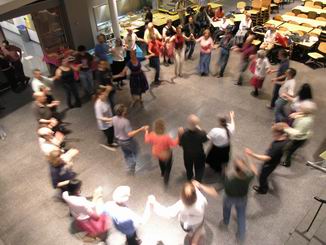MIT Folk Dance Club
presents--
International Folk Dancing
Updated: 28 March, 2019
Participatory line, circle, and couple dancing for everyone from
eastern Europe and the world
About one Sunday per month, 8:00 pm -
10:30 pm
See the schedule of locations and special events.
(These dances may also be listed on the MIT Events Calendar.)
The MIT Folk Dance Club recorded information line is
617-253-FOLK. We are unable to update it often, so please check
this website or the e-mail list for the
latest information.
Now more than ever--we're an
all volunteer organization, and we depend on our dancers to help keep
us going! Even a little help makes a big difference, and please
feel free to ask us about setup, put-away, or sharing programming
duties with one of us (i.e., you don't have to go it alone!).
Thanks!
If
you're new to dancing or
missed out on the Beginners' Nights:
Come check us out anyhow! Bring
your friends! No experience necessary!
New dancers are welcome to join us any Sunday, not just at Beginners'
Nights. Come any time, though the best time is the earlier part
of the evening (roughly 8:00-9:30) since a certain number of dances are
usually taught during that period. Many of our dances are
straight-forward enough to pick up "on the fly", and folks will invite
you to join the line (or circle, or whatever the formation might be)
for those dances. Later in the evening, we will blend in
some more complex dances to appease the more experienced dancers, but
you should be aware that most of our dance programmers make an effort
to maintain a mix of levels that includes a certain percentage of
easier dances right through the end of the evening, so there will be
plenty for you do to do in the latter part of the evening as
well. If you're unsure about whether to join in a dance you
haven't seen before, a good tactic is to get behind the line of
dancers for a few moments and watch their steps to assess whether you
feel
comfortable "faking" this one. And, yes, it is perfectly
acceptable to "fake" a dance - just make sure you're moving more or
less the same direction as the other dancers in the line, keep your
grip relaxed and smile a lot - and no one will notice what your feet
are or aren't doing. This is something all of us, even
experienced dancers, find ourselves doing from time to time.
Please avoid using perfumes or scented personal care products
while at the dances - some of our dancers are allergic to these.
Footware note: For your comfort & safety, please wear sturdy
low-heeled shoes that you're comfortable running & jumping
in.
Back to top of page
The
kinds of dancing that we do and how we operate:
We dance mostly village dances and some dances choreographed in folk
style to the complex and fascinating rhythms and music of
Eastern Europe: Bulgaria, Romania, Serbia, Croatia, Greece, and
others. We round out the repetoire with a few dances from other
parts of Europe and the world (such as Israel, France, Russia, even
England and the US). We have a "core" repetoire which you will
pick up as you attend a succession of Sunday nights, but we're also
always acquiring fun and interesting new dances from a number of
sources. Some of the dances are lyrical and slow, others are
great aerobic exercise and give you a chance to really move.
Most of the dances move
in the traditional lines or circles; the repetoire also includes some
couple dances (but you don't need to bring a partner).
The club owns a large and enviable collection of old, rare, as well
modern recordings which we dance to most Sunday evenings. There
are also a number of talented performers of this music in the area, and
on occasion we are able to have live music for dancing - those will be
noted in the schedule. Each Sunday we have a programmer
who determines what
dances we will do and sets up the flow of the evening. In
addition to making sure dances get taught and that we get the right mix
of easy/hard, the programmer also works from a request board;
anyone can write a
request on this board, so bring along names of dances that you know
from here or from elsewhere.
Approximately half-way through the evening, we usually pause for some
brief announcements.
Back to top of page
E-Mail
list
The Sunday night e-mail list is the most reliable way to get
current and last minute information. This will include reminders,
room updates, special events, and the rare cancelation. This list
will be used for this purpose only; it is not a discussion list, and
only the list managers can post.
To subscribe to the list, send a blank e-mail to fdc-international-subscribe[at]mit[dot]edu
or fill out this form:
Back to top of page
Comments & suggestions for
this page to:
fdc [at] mit [dot] edu
Return to MIT Folk Dance Club home page


